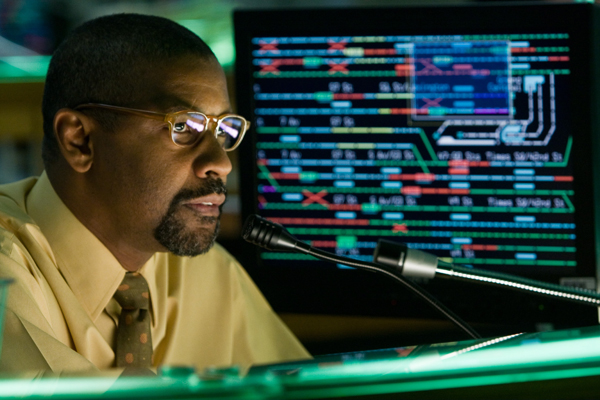Movie review by Greg Carlson
It should go without saying that the freshly released Tony Scott remake of the 1974 Joseph Sargent version of “The Taking of Pelham One Two Three” is utterly unnecessary. Most remakes, reinterpretations, and re-imaginings are. Blasting off with a thumping remix of Jay-Z’s “99 Problems,” the new “Pelham” honors the original hijack/caper movie at least as far as painting a portrait of life in and around the NYC subway system. While the original movie’s tough, gritty New York attained a cult following (with members including the Beastie Boys and Quentin Tarantino), Scott’s version of the city emphasizes a post-Giuliani metropolis understandably concerned with the safety of its metro transit customers and inevitably oriented toward the possibility of terrorism.
Despite his unsavory, headache-inducing predilection for swooping camera movements and jumpy, hyperactive editing, Tony Scott manages to inadvertently get a few things right in his retelling. The supporting cast members, including John Turturro, James Gandolfini, Luis Guzman, and Michael Rispoli, often transcend the boilerplate dialogue offered to their characters. Denzel Washington’s self-effacing transit official provides the star with another opportunity to skillfully project grace under pressure (even if one misses the grumpiness of Walter Matthau). And despite considerable gaps in logic, the pacing is confidently speedy.
Robert Shaw’s cagey Mr. Blue is replaced by a jittery, twitchy John Travolta seemingly fashioned after a Tom of Finland leatherman illustration. Travolta’s aptly named Ryder is an anarchic bundle of nerves whose seductive aural courtship of Denzel Washington’s Walter Garber infuses the film with a homoerotic subtext that closely parallels the “Top Gun” speech delivered by Tarantino in “Sleep with Me.” Scott’s hyper-masculine world – which predictably has little use for women – does make time for plenty of sadism and suggestions of prison rape.
Many of the director’s worst tendencies manifest prominently throughout the movie. Vehicular mayhem occurs much more than necessary. Characters repeatedly point out painfully obvious information that the audience has just seen. The product placement is as shameless as the musical score is manipulative. In addition, all the modernizing updates fail to enhance the narrative, especially the villain’s intense interest in online stock market updates and an undernourished subplot in which a hostage maintains an open video chat with his girlfriend (open question to screenwriter Brian Helgeland: why does the girlfriend have to be depicted as stupid and emotionally needy?).
Finally, “The Taking of Pelham 1 2 3” stumbles down the stretch, cutting between a silly runaway train straight out of D.W. Griffith and a good guy/bad guy standoff with only one possible outcome. While the 1974 version depended on a nearly farfetched detail to sew up the story, it worked within the particular world that had been created and kept faith with the film’s dark humor. Scott’s universe, on the other hand, is much less clever and much more predictable. Where the 1974 version showed considerable smarts, the 2009 attempt swaps in action. The difference between the two movies (purposefully ignoring the made-for-television version of 1998) is simple: one leaves the latest version feeling like one of the subway car hostages, relieved to be free of the ordeal.
